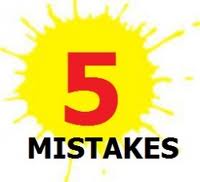 1. Starting the sales process by attempting to get an appointment.
1. Starting the sales process by attempting to get an appointment.
I know that Dale Carnegie told you to meet face-to-face. But what else are you doing that was initiated in 1937? Oh. That’s right. The typical sales model of focusing on solution placement.
Buyers only buy when their entire Buying Decision Team is on board and when there is buy-in to bring in something new without causing major disruption. Trying to make an appointment before they know how to manage the elements that will touch the final solution will incur the following problems:
- It’s a double sale
– first selling an appointment and then attempting to sell the solution to only those people who will see you (although many who don’t want to see you still need your solution). You will lose over 90% of your prospective buyers this way. [But if you begin by helping them first recognize their own excellence/change criteria, you can begin your sales job immediately – and without an appointment.] - You will end up seeing only one or two people at your appointment and may need to make several visits. Trust me: the Buying Decision Team is much, much larger than the folks you will initially meet — although a prospect will probably not know the full complement of Decision Team members until they are almost ready to buy. [Until buyers know all of the idiosyncratic and political issues that might be involved with bringing in a new solution, they cannot know who needs to be involved in the final decision. You can help them, starting on the first call.]
- You are turning off people that can and might buy you. Buyers buy using their buying patterns, not your selling patterns.
2. Treating the ‘need’ as if it were an isolated event. A need never exists on its own. It sits within a system of people and policies and workarounds and relationships. Until everything around it has a plan to get resolved simulteneously, they will not fix ‘the problem’: there is no such thing as one issue, sitting and waiting to be fixed. And the adjacent issues are not part of your solution or your sales initiative.
3. Offering solution data too soon. Until or unless the entire Buying Decision Team is ready and willing and able to purchase a new solution, the data you are offering them is too much, too soon. They do not need the data. For example: You don’t need data about the new gym until you have already decided to lose weight, get fit, get up at 3:00 a.m to get to the gym before work, etc. It’s not about the gym. When you start by gathering/sharing data, you are beginning at the wrong end of the buying journey.
4. Assuming the need should be resolved on the sales person’s time frame. Contrary to your belief, the buyer is not sitting and waiting – with bated breath – for you to show up as SuperSeller and fix their ‘problem.’ If they had such a strong need, they would have fixed it already. They are managing fine without you. Maybe not perfectly, but well-enough to maintain their status quo while getting the necessary buy-in for change.
5. Trying to find The Decision Maker. The Decision Maker? What does that MEAN? If the gatekeeper doesn’t let you through, she’s the decision maker. If the CSO suddenly and inappropriately gets involved and disrupts the forward trajectory – and it isn’t even in his/her area of responsibility – s/he is the decision maker.
Every. Single. Person. Who. Touches. The. Solution. Is. A. Decision. Maker.
Clear?
Two things need to happen before you can sell a solution: 1. the buyer has to figure out how to get appropriate internal buy-in and traverse the route (not merely understand it) from where they are to where they want to be; 2. the buyer must choose a solution and manage all of the fallout that bringing in your solution would involve.
No matter what their need – which they’ve lived with until now – or how well your solution fits, nothing will happen until the buyer’s decision journey is complete.
Would you rather sell? Or have someone buy? They are two different activities.
sd
Read my latest book for more on these topics: www.dirtylittlesecretsbook.com or buy some of my learning accelerators so you can learn how to add a new skill set www.buyingfacilitation.com





6 thoughts on “The 5 selling mistakes that lose business”
Pingback: Tweets that mention The 5 selling mistakes that lose business | Sharon-Drew Morgen -- Topsy.com
Pingback: Fighting for Failure: why modern sales practices are illogical | Sharon-Drew Morgen
Pingback: Facilitating the Buyer’s Journey: a definition | Sharon-Drew Morgen
Pingback: Buyers don’t sit and wait for sellers | Sharon-Drew Morgen
Nice review, it’s good to hear this stuff and make you think about your approach.
Greg
DISQUS
NOTE: This comment is waiting for your approval. It is not yet published on your site.
======